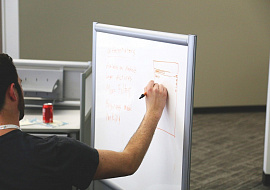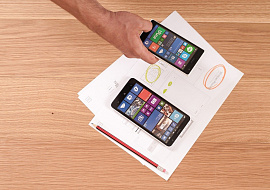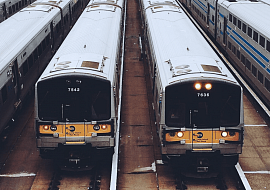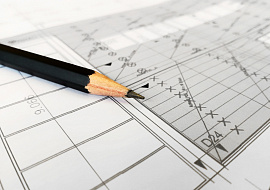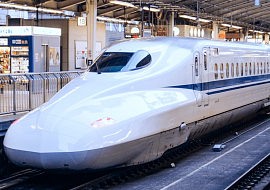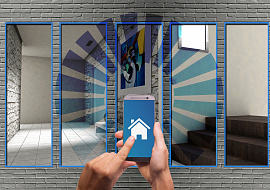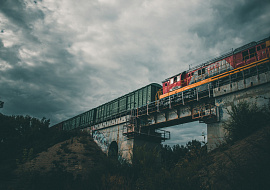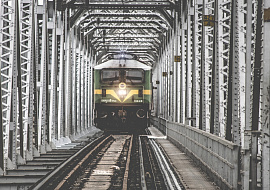How Do Modern Railroad Signaling Solutions Help Increase Rail Capacity?
It’s therefore not surprising why the rail upgrading projects aimed at increasing the capacity prevail among others. Congestion caused by the growing demand for this mode across various industries for freight transportation, rail weight limits, fleet size, and signaling failures increasingly influences both freight and passenger rail. However, there is no single approach to how to improve the rail capacity, and every rail project should be addressed separately.
As the U.S. Department of Transportation reports, rail traffic volume is expected only to grow and reach +50% of today’s traffic for the freight rail within the next 30 years. Promising prospects are given also for the high-speed rail market that has started to develop more recently in North America: it is projected to grow by 9.1% every year until 2030. On the one hand, it is a good sign for rail companies who will definitely be recruited for upgrading the existing rail infrastructure that clearly can’t satisfy the request of soaring traffic. But on the other hand, this increase causes some uncertainties about the necessity a common approach to increasing rail capacity, Otherwise, you’ll need to modernize again and again very soon. In this article, PSA’s team of analysts and signaling engineers share their expertise on modernization of signaling systems and why modernization should be primarily considered for improving rail capacity. Additionally, we’ll discuss what is to be done when the rail line serves various types of trains and debate whether it is always worth replacing convention signaling with digital systems on all sections of the rail line.
Capacity and Railroad Signaling Solutions – How Are They Connected?
Traditionally, to increase the throughput of an existing rail line it’s necessary to modernize one or several components of the rail system – rolling stock, construction objects, or railroad signaling solutions. Modern and fast trains, such as high-speed rail, obviously provide higher capacity since more trains would pass by per unit of time. However, it is very likely for the new rolling stock to bring about other components modernization, for instance, rail-sleeper grid replacement to withstand the larger dynamic loads. It also frequently entails implementing modern signaling systems with radio-based or GPS tracking, allowing tracking of the train’s location online precisely at very high speeds. Building the platforms, rails, or grade-separated junctions is usually a highly effective way to get the capacity raised, especially when the rail section is for various kinds of trains, both passenger and freight. But you are unlikely to consider this way first of all since capital expenses on maintaining the existing railroads are much lower than on building the new infrastructure.
Thus, modernizing the rail signaling system benefits financially first. A huge advantage of this is that it can be performed seamlessly – without interrupting the transportation process even for a minute. Second – both hardware and software for railroad signaling solutions are more budget-friendly than the construction work needed in these cases. Therefore, if your goal is increasing the throughput of a line or section, we advise that you consider modernizing the signaling system first, namely:
-
Replace the whole signaling system with the new generation
-
Replace the components of the legacy system
-
Modernize separate sections of the rail line
-
Update the system with new components
In general, modern railroad signaling solutions based on the virtual block system, such as CBTC, PTC, and ETCS, were designed to increase the train’s capacity since they don’t limit train speed potentially, and “free” trains from the wayside equipment. However, their implementation can be delayed not only through financial reasons, but also due to incompatibility issues, location features, or simply low traffic of the line. Until the rail industry predominantly dictates the tempo of implementing advanced digital technologies, there is no reason to rush to implement CBTC, PTC, or ETCS en masse at every rail section. In our experience, being pragmatic and competently combining legacy and new systems by linking their component reliably is much more profitable for reaching the target capacity in most cases. Let’s consider these cases in detail.
How to Reach Target Capacity through Modernization of Railroad Signaling Solutions?
In fact, the core goal for the signaling designer is to calculate a safe distance for the trains moving at a particular speed followed by each other. It is much easier to identify this parameter and optimize capacity for trains moving at the same speed and, preferably, synchronously. In most cases, an increase in throughput becomes a real challenge through the trains’ speed differential, and we need to consider every detail when choosing the optimal way of modernizing the signaling system. After a detailed survey of the landscape, turns and slopes, electricity, connectivity, and so on, experts say if the target capacity can be reached within a line through railroad signaling solutions.
Replacing the whole system of the rail line with modern railroad signaling solutions
The replacement of the entire block signaling system with the digital system suits projects with very high speeds and train frequency required. It is performed mostly in two cases:
-
Metro if it was not updated in time
-
The line is to be converted to high-speed
As you see, we talk about passenger trains in these cases first and offer all the relay components and logic to be replaced with digital versions. It allows the use of wireless radio-based connectivity to precisely track the location and cope with a high frequency of train movements that is technically impossible for conventional signaling systems. Such systems also allow more flexible movement management, for instance, running trains faster during peak times and slower for periods of time with low passenger numbers. Such careful management thereby helps slow down the deterioration of the rolling stock.
Digital railroad signaling solutions can also be considered within smart city projects which require access to the status of the train systems online. In this case, a microprocessor-based digital signaling system provides rail companies with a more detailed view of the rail signaling equipment and allows them to perform predictive maintenance.
Since digital signaling systems can suffer from incompatibility issues with legacy systems and generally are not immune to failures, we advise saving the analog system as a “reserve.” The reserve would take on all signaling functions if the digital system fails, enabling investigation into the reason for the failure, and restoring the signaling system without interrupting transportation processes.
Replacing the components of the railroad signaling solutions
Installing microprocessor-based signaling equipment instead of relay-based versions, without shifting from block signaling, may be reasonable during signaling failures and congestions that are caused by aging equipment on relatively loaded rail lines. It is essential because signaling software is responsible for minimalizing the interval between trains followed by each other while saving maximum allowable speed. Operating on microprocessor logic, such systems ensure faster reactions which means higher potential train speed in comparison with relay logic. Surely, the difference between microprocessor and relay reaction is insignificant for most lines except metros and high-speed as we described above. But digital systems have versatile connectivity potential and present train data in a more convenient way for dispatchers which also mitigates risks of failures.
Usually, the idea of replacing outdated components is supported by other goals. For instance, when it is necessary to free up space from bulky equipment, improve the maintenance of interlocking equipment, or when it is planned for new trains to be run within the line in the future – the microprocessor systems can be a great help there.
Need help?
Modernizing rail sections with modern railroad signaling solutions
Rather than a full line upgrade, specific components can be targeted that control certain areas like:
-
significant junctions
-
crossings of several railways
-
overloaded sections that entail congestion
It predominantly refers to freight rail and also to lines that serve various types of trains, both passenger and freight. The traffic intensity on such railroads continues to increase, subsequently decreasing the average train speed. This causes logistic issues as we see in Texas serving freight flows to Mexico. Also, it is relevant for lines that serve various types of trains, both passenger and freight. It is clear that the widespread implementation of digital signaling systems, like PTC or CBTC, is unprofitable through the long distances of railroads. Thus, the main goal here is to unload the most “problematic” areas while the main task for the signaling department is to match various signaling systems without sacrificing capacity and compatibility. In light of this, it is advisable to study systems more precisely, create simulations and hold more tests to predict the system’s behavior in various rail scenarios.
Updating the existing railroad signaling solutions
There is a range of cases when the rail project aimed to increase capacity can be delivered without modernizing the signaling system – when the existing signaling system satisfies the target capacity of the rail project. If it is a great supply for the existing relay system’s life we can simply leave it, or update it with new relay components if its life is going out soon. It would be an updated system with new-produced components, but not a modernized one. This is the most cost-effective way of signaling system updates, which is especially critical when upgrading the other components to increase capacity.
For instance, when the newly developed suburban areas are located near railroads that used to be low-loaded. As we expect four times more traffic on this line, the modern locomotives have to run more often, or faster. The existing block signaling system can satisfy the request for such commuter rail but the existing rails might not withstand new loads and need to be replaced with heavier rails. It turns out that here we update the system’s components while leaving its block nature.
Wrapping up
Railway transport has every chance to become the transport of the future because of its ecology-friendly nature and smart and fast potential. To meet this expectation, rail companies have to modernize the existing rail infrastructure, and implement new railway signaling solutions, to be ready for more passenger and freight traffic.
-
A unified approach to signaling system modernization can simplify freight transportation within North America, but the widespread implementation of digital signaling is economically unprofitable.
-
Since the rail industry dictates the tempo of its digitizing, we can equally consider legacy and cutting-edge systems for signaling modernization by examining every case under the magnifying glass.
-
Digital signaling systems with virtual blocks and advanced connectivity help reach the highest capacity and is obligatory for metros and high-speed.
-
To balance the budget, the signaling system for a particular line can be modernized partially, for instance, through the most loaded sections.
-
It’s impossible to match various signaling systems within the rail line without sacrificing maximum speed parameters but it is justifiable within the most loaded rail sections.
From Automatic Block Signaling to advanced CBTC, PTC, and ETCS systems, PSA assists rail companies in signaling system design connecting controllers, interlocking, in-cab, and dispatching systems. Let’s get in touch for a custom approach to your project.






